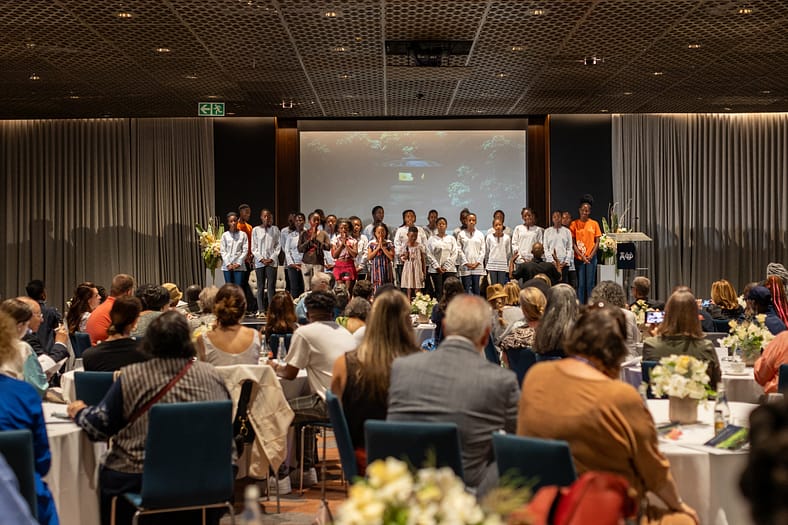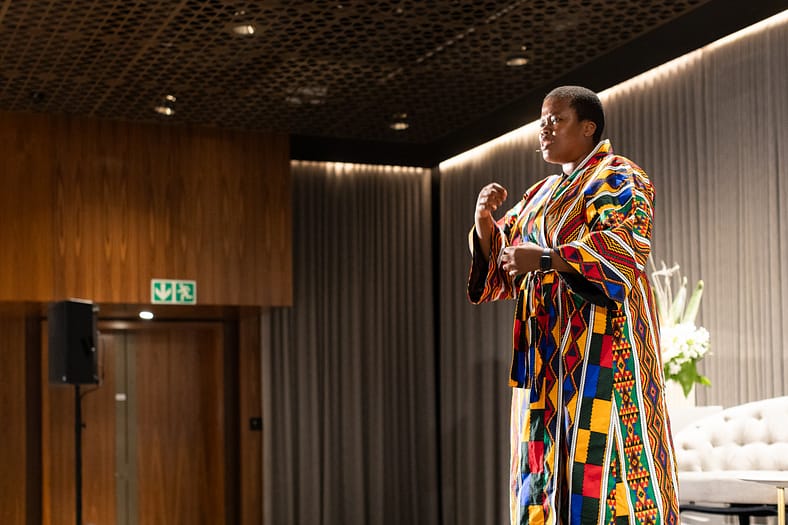
Written by Deshnee Subramany
Years after former Constitutional Court Justice and anti-apartheid activist Albie Sachs lost his right arm and vision in his eye in a bomb that exploded in his car in 1988, he met the man responsible for planting the weapon who told of his actions as an apartheid collaborator. Filled with recognition of the injustice done to him, on this occasion Justice Sachs was unable to shake the man’s hand. Rather, he requested the man to express his remorse and contribute to South Africa by admitting his crimes at the Truth and Reconciliation Commission (TRC) – a tribunal created to hear and record crimes relating to human rights violations during apartheid. Among other provisions under the TRC, victims could receive reparations and rehabilitation, while perpetrators could be granted amnesty.
A few years later, the same man greeted Justice Sachs at a party. He told the judge that he followed through with his promise, and this time, the judge shook the man’s hand. Then, according to third-party reports, the experience left the the man collapsed in tears in a corner of a room for a few days.
This story was part of Justice Sachs’ closing remarks at Japan Institute’s Peace Symposia in Cape Town and Johannesburg on November 30th and December 4th, 2023. The Peace Symposia in South Africa were the fourth and fifth in an international series exploring the evolving role of art, cultural institutions, and public spaces as platforms for peacebuilding and community engagement.

Taking place at the Kirstenbosch Gardens and Houghton Hotel respectively, each cultural conversation celebrated its unique location in South Africa, a country with a democracy of just 30 years after a history of colonialism, apartheid, and human rights abuses. Thanks to the efforts of Black South Africans and their allies, a democracy was established in the nation in 1994, and with it, a constitution thought to be among the most progressive in the world.
Presented in collaboration with the Nobel Peace Center and over a dozen South African partner organizations, the symposia carried themes of restoration, love, pain, and hope – and took place a few days before the 10th anniversary of the passing of Nelson Mandela, South Africa’s first democratically elected president and Nobel Peace Prize laureate.
Japan Institute of Portland Japanese Garden CEO, Steve Bloom, discussed how a Japanese garden in the United States helped unite a community split along racial lines after World War II. “That garden that a community didn’t want to the point of almost murdering its Garden Director has now become a cultural jewel of the city of Portland,” Bloom shared. “That same community that did not want this garden [in 1961] raised $37 million in private donations to double the size of it. Art, love, and nature are as important as dialogue, peace negotiations, or treaties.”

The lineup of speakers included a diverse set of South African and foreign thought leaders. Among the participants were Keynote Speaker Caryl Stern, Chief Impact Officer, LionTree & Former CEO of UNICEF USA, Ann Burroughs, CEO and President of the Japanese American Museum in L.A, Marc Lubner, Group CEO of Africa Tikkun, Nick Boraine, Associate Artistic Director, Global Arts Corps, Ilvy Njiokiktjien Videographer and Producer of the documentary Born Free, and Photographer and Storyteller at VII Photo. Aki Nakanishi, Arlene Schnitzer Curator of Art, Culture, and Education, represented Portland Japanese Garden in the panel discussions. Participants preceded their discussions with presentations that explored their experiences in dialogue and peacemaking from their unique experiences.
Program presenters and panel moderators were also remarkable. In Cape Town, Journalist Crystal Orderson moderated the discussion, and Tumy Boitumelo, Founder and Managing Director of AYAMA Creatives, served as Program Director. The Johannesburg Symposium was moderated by Avril Joffre UNESCO Chair for Cultural Entrepreneurship and Policy, and member of the Cultural Policy and Management Department at WITS University faculty, and was gracefully presented by René Alicia Smith, Associate Professor and Head of the WITS School of Arts.
While each symposium embraced both cities’ unique energy, both installments were quintessentially South African. As a tribute to the lineage of the country’s indigenous people, Liverpool Biennial 2023 curator and sangoma (a respected healer among South Africa’s indigenous people) Khanyisile Mbongawa called in the ancestors of each audience member present. Her poignant chants and calls arose intense pride and respect throughout the room. Mbongawa stirred deep emotions and painful memories during her presentation about pain, that victims of violence are often left to carry the burden of peace, and how the isiZulu word “uxolo” means so much more at its core than the English word for peace. In a country still grappling with racial, economic, and social justice, betrayal and hurt are regular emotional responses still today.
Among the most memorable presentations was by Lungi Morrison, granddaughter of one of South Africa’s best-known activists and name-giver of the Rainbow Nation Archbishop Emeritus, Desmond Tutu. She explained her personal strangeness to the world as a child of exile and how, throughout her travels, she was preoccupied with one question, “If the sun would rise and set without fail each day and billions of species, majority still undiscovered, particularly flora, on this turquoise floating stone we call earth, why are peace and love so elusive?”

Morrison offered three provocations central to the conversations in both cities.
“Humanity absolutely does not require any further evidence that what the world needs desperately right now is healing at the individual level to achieve lasting peace,” she shared. Secondly, if we focus on that which connects us over those that appear to perhaps divide us or are polarizing, we’re ultimately reminded of our shared humanity, our unique stories captured through such modalities as art and nature, where no matter your circumstances, we can find peace residing therein.”
“Finally, in as much as we are talking about peace, it is important to also posit that imperfection, challenge, sadness, trauma are all also part of the human experience, so we should take those in as well and consider that these don’t necessarily denote the absence of peace, but in fact the commitment and recommitment we must make to tendering the process of cultivating inner peace in order to sustain world peace.”

In addition to the symposia, Japan Institute’s Art for Peace Commission Scholarship explored the themes of beauty, art, and nature through visual arts. Twenty students from universities in Johannesburg and Cape Town, differing in gender, religious, social, economic, ethnic and political identity, were paired and tasked with exploring the concept of “The Other” to challenge stereotypes and stimulate discourse about divides, inclusion and diversity.
Wits Young Artist winner Khulekani Magudulela’s sculpture work explores clashes of cultures as “The Other”, using an indigenous personification of what he calls “that which was before time”. Like Morrison, he also spoke about connection and communication through that connection.
“Being a Zulu person in an institution, where you come in as someone who is so knowledgeable yet you know nothing here, has made me ‘The Other,’” Magudulela noted. “So, how best do I communicate how my surroundings are molding me – and how my lineage and what I’ve inherited from my ancestors fit into that?”
“In my work, I like to speak to the challenges I face, and it links to my spirituality and the gift itself. Eventually your ancestors start showing you some connections that you have with your elders. This body of the work looks like a bag of bones – there’s an elder in my family who also has the gift and the bag of bones represents that. I seek the lineage of my family. My collaborator’s work features a tale about a goddess who was so beautiful she could not be seen by people, so whenever she went out into the sun her skin would burn. So it’s also the connection you have with other people and how they perceive you during the day, as well as your own connection with yourself. How do you want to navigate those connections?”
The gift he refers to is his spiritual abilities – healing and using himself as a conduit for ancestors to guide their bloodlines still present on earth.

The afternoon of the event featured a performance by internationally renowned producer, poet, and writer Siphokazi Jonas, as well as samples of work by the three winners of a challenge co-hosted by The Poetry Society’s Young Poets Network. Guests were also privileged to experience an Afrika Tikkun Chorus rendition, as well as a classical duet by two young musicians featured in photojournalist Ilvy Njiokiktjien’s 12-year documentary project, Born Free – Mandela’s Generation of Hope.
The symposia were sealed with a promise of friendship and collaboration, anchored by a Celtis africana planted by Portland Japanese Garden and Japan Institute at the Johannesburg Botanical Gardens on December 5th. As was shared later in a press release, Member of Mayoral Committee for Community Development Cllr Lubabalo Magwentshu noted the gift was welcome addition.
“As we gather for this significant occasion today, may this tree taking root in our African soil symbolize the enduring spirit of peace and cooperation between nations,” Magwentshu said. “May these joint ventures inspire creativity, build bridges, and leave an indelible mark on our shared journey toward a more peaceful and interconnected world.”
Deshnee Subramany is a journalist and digital media consultant living in Johannesburg, South Africa.
More Photos From South Africa
Japan Institute’s peace programming is made possible through Robert and Deborah Zagunis.






